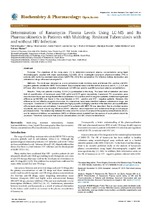Determination of kanamycin plasma levels using LC-MS and its pharmacokinetics in patients with multidrug-resistant tuberculosis with and without HIV-infection
Date
2015Author
Mugabo, Pierre
Abaniwonda, Mercy, I.
Theron, Danie
Hassan, Shafick, M.
Stander, Marietjie
Van Zyl, Leonie
McIlleron, Helen
Madsen, Richard
Metadata
Show full item recordAbstract
The objectives of the study were: (1) to determine kanamycin plasma concentrations using liquid
chromatography coupled with mass spectrometry (LC-MS), (2) to investigate kanamycin pharmacokinetics (PK) in
patients with multi-drug resistant tuberculosis (MDR-TB), (3) to find out whether HIV infection, kidney dysfunction and
antiretroviral drugs influence kanamycin PK.
The study was designed as a non-randomized study involving male and female HIV- positive and HIVnegative
patients admitted for MDR-TB treatment. Blood samples were collected before (baseline) and ½, 1, 2, 4, 8 and
24 hours after intramuscular injection of kanamycin. LC-MS was used to quantify kanamycin plasma concentrations.
Thirty one patients including 13 HIV (+) participated in the study. The lower limit of detection and lower
limit of quantification of kanamycin were 0.06 μg/ml and 0.15 μg/ml respectively. Kanamycin PK parameters were
described and there was no significant difference between HIV-positive and HIV-negative patients. A statistical significant
difference (p=0.0126) was found in the renal function in HIV - positive and HIV - negative patients. However, this
difference did not affect kanamycin elimination. No interactions have been identified between antiretroviral drugs and
kanamycin. Conclusion: LC-MS analysis method is highly specific and highly sensitive in the detection and quantification
of kanamycin plasma concentrations. Kanamycin PK in patients with MDR-TB was described. Due to a limited number
of patients, we cannot rule out any influence of HIV - infection, renal impairment and antiretroviral drugs on kanamycin
pharmacokinetics. The relationship between the area under the curve of kanamycin free plasma concentrations (fAUC)
and its minimum inhibitory concentrations (MIC) on M.tuberculosis isolated from the sputum of each patient should be
assessed. Therefore, kanamycin free plasma concentrations and MIC should be determined.

